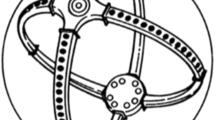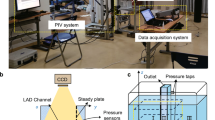Abstract
In the absence of strong gravitational forces in the microgravity environment of space, surface tension forces dominate, and special devices called liquid acquisition devices (LADs) are required to separate and control liquid and vapor phases of the propellant upstream in the storage tank to prevent vapor ingestion into the transfer line. One type of device called a screen channel LAD uses three solid sides and one porous side of a channel to allow liquid to flow, but also to act as a barrier to vapor ingestion. During the transient startup of propellant transfer, the liquid must be accelerated from rest to the steady flow demand velocity, which causes the screen to deflect or comply. Compliance data is required for accurate transient LAD analyses; most design codes only consider steady state analysis. (Camarotti et al. in Microgravity Sci Technol 31: 109-122, 2019b). presented fundamental screen compliance data as a function of mesh type for circular screen geometries. The purpose of this paper is to present the effect of ramp rate (i.e. the volumetric flow rate at which liquid is withdrawn from underneath the screen) on LAD screen compliance for rectangular screen geometries. Three different screen types and three different aspect ratios were tested across a wide range of liquid withdrawal rates using isopropyl alcohol (IPA) to examine this effect.














Similar content being viewed by others
References
Alexander, G., Barksdale, T., Hise, R., Lunden, K., Paynter, K.: Experimental Investigation of Capillary Propellant Control Devices for Low-Gravity Environments. NASA-CR-110755, (1970)
Armour, J., Cannon, K.: Fluid Flow through Woven Screens. AIChE J. 14, 415 – 420 (1968)
Bingham, P., Tegart, J.: Wicking in Fine Mesh Screens. Orlando, FL, (1977)
Burge, G., Blackmon, J., Castle, J.: Design of Propellant Acquisition Systems for Advanced Cryogenic Space Propulsion Systems. Las Vegas, NV, 5–7 (1973)
Cady, E.: Study of Thermodynamic Vent and Screen Baffle Integration for Orbital Storage and Transfer of Liquid Hydrogen – Final Report. NASA-CR-134482, (1973)
Cady, E.: Effect of Transient Liquid Flow on Retention Characteristics of Screen Acquisition Systems – Final Report. NASA-CR-135218, (1977)
Camarotti, C., Deng, O., Darr, S., Hartwig, J., Chung, J.: Room Temperature Bubble Point, Flow-through-Screen, and Wicking Rate Experiments for Screen Liquid Acquisition Devices. Appl. Therm. Engi. 149, 1170–1185, (2019a)
Camarotti, C., Deng, O., Darr, S., Hartwig, J., Chung, J.: Screen Compliance Experiments for Liquid Acquisition Device Screens. Microgravity Sci. Technol. 31, 109–122, (2019b)
Conrath, M., Dreyer, D.: Gas Breakthrough at a Porous Screen. Int. J. Multiphase Flow, 42, 29–41 (2012)
Fries, N., Odic, K., Dreyer, M.: Wicking of Perfectly Wetting Liquids into a Metallic Mesh. Proc. 2nd Int.l Conf. Porous Media its App. Sci. Eng., Kauai, HI, 17–21 (2007)
Grebrenyuk, Y., Dreyer, M.: Wicking of Liquid Nitrogen into Superheated Porous Structures. Cryogenics, 78, 27–39 (2016)
Hartwig, J., Mann, J.J.: A Predictive Bubble Point Pressure Model for Porous Liquid Acquisition Device Screens. Journal Porous Media 17(7), 587–600 (2014a)
Hartwig, J.W., Darr, S.R.: Influential Factors for Liquid Acquisition Device Screen Selection for Cryogenic Propulsion Systems. Appl. Therm. Eng. 66(1–2), 548–562 (2014b)
Hartwig, J., Darr, S.: Analytical Model for Steady Flow through a Finite Channel with One Porous Wall with Arbitrary Variable Suction or Injection. Phys. Fluids 123603, 26 (2014c)
Hartwig, J., McQuillen, J., Chato, D.: Screen Channel LAD Bubble Point Tests in Liquid Hydrogen. Int. J. Hydrogen Energy 39(2), 853–861 (2014d)
Hartwig, J., McQuillen, J., Chato, D.: Warm Pressurant Gas Effects on the Bubble Point for Cryogenic Liquid Acquisition Devices. J. Thermophys. Heat Transfer 29(2), 297–305 (2015a)
Hartwig, J., McQuillen, J., Jurns, J.: Screen Channel Liquid Acquisition Device Bubble Point Tests in Liquid Oxygen. J. Thermophys. Heat Transfer 29(2), 353–363 (2015b)
Hartwig, J., McQuillen, J.: Screen Channel Liquid Acquisition Device Bubble Point Tests in Liquid Methane. J. Thermophys. Heat Transfer 29(2), 364–379 (2015c)
Hartwig, J., Hu, H., Styborski, J., Chung, J.: Comparison of Cryogenic Flow Boiling in Liquid Nitrogen and Liquid Hydrogen International. J. Heat Mass Transf. 88, 662–673 (2015d)
Hartwig, J.: Liquid Acquisition Devices for Advanced In-Space Cryogenic Propulsion Systems. (2015e)
Hartwig, J.: Propellant Management Devices for Low Gravity Fluid Management: Past, Present, and Future Applications. AIAA Journal of Spacecraft and Rockets 54(4), 808–824 (2017)
Hastings, L., Bolshinskiy, L., Schunk, R., Martin, A., Eskridge, R., Hamill, B., Gomez, C., Frenkel, A., Grayson, G., Pendleton, M.: Thermal Integration of a Liquid Acquisition Device into a Cryogenic Feed System. NASA-TP-2011–216474 (2011)
Hernandez, A., Calvo, J., Pradanos, P., Tejerina, F.: Pore Distributions in Microscopic Membranes. A Critical Analysis of the Bubble Point Extended Method. J. Membr. Sci. 112, 1–12 (1969)
Jaekle, D.: Propellant Management Device Conceptual Design and Analysis: Galleries. in 33rd AIAA/ASME/SAE/ASEE Joint Propulsion Conference & Exhibit, (1997)
Paynter, H.: Acquisition/Expulsion System for Earth Orbital Propulsion System, Volume III, Cryogenic Test. MCR-73–97, NASA-CR-134155(1973)
Savas, A., Hartwig, J., Moder, J.: Thermal Analysis of a Cryogenic Liquid Acquisition Device Barrier under Autogenous and Non-condensable Pressurization Schemes. Int. J. Heat Mass Transf. 74, 403–413 (2014)
Symons, E.: Wicking of Liquids in Screens. NASA-TN-D-7657, (1974)
Vasireddy, S., Camarotti, C., Hartwig, J., Chung, J.: Liquid Acquisition Device Screen Compliance Experiments with Rectangular Geometry for Microgravity Applications. Microgravity Sci. Technol. (2021). https://doi.org/10.1007/s12217-021-09921-4
Acknowledgements
This work was supported by National Aeronautics and Space Administration (NASA) under the award number 80NSSC18P2582. This research was also partially supported by the Andrew H. Hines, Jr./Progress Energy Endowment Fund at the University of Florida.
Author information
Authors and Affiliations
Corresponding author
Ethics declarations
Conflicts of interest
None declared.
Additional information
Publisher's Note
Springer Nature remains neutral with regard to jurisdictional claims in published maps and institutional affiliations.
Rights and permissions
Springer Nature or its licensor holds exclusive rights to this article under a publishing agreement with the author(s) or other rightsholder(s); author self-archiving of the accepted manuscript version of this article is solely governed by the terms of such publishing agreement and applicable law.
About this article
Cite this article
Camarotti, C., Hartwig, J., Yaegers, D. et al. The Effect of Liquid Withdrawal Rate on Screen Channel Liquid Acquisition Device Screen Compliance. Microgravity Sci. Technol. 34, 86 (2022). https://doi.org/10.1007/s12217-022-10001-4
Received:
Accepted:
Published:
DOI: https://doi.org/10.1007/s12217-022-10001-4




